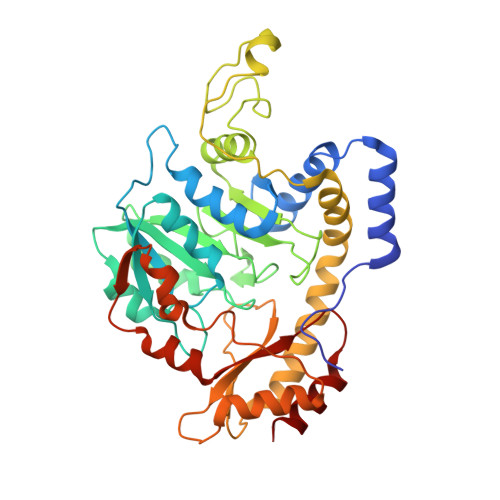A Structural Study of GDP-4-Keto-6-Deoxy-d-Mannose-3-Dehydratase: Caught in the Act of Geminal Diamine Formation
Cook, P.D., Holden, H.M.(2007) Biochemistry 46: 14215-14224
- PubMed: 17997582
- DOI: https://doi.org/10.1021/bi701686s
- Primary Citation of Related Structures:
2R0T - PubMed Abstract:
Di- and trideoxysugars are an important class of carbohydrates synthesized by certain plants, fungi, and bacteria. Colitose, for example, is a 3,6-dideoxysugar found in the O-antigens of Gram-negative bacteria such as Escherichia coli, Salmonella enterica, Yersinia pseudotuberculosis, and Vibrio cholerae, among others. These types of dideoxysugars are thought to serve as antigenic determinants and to play key roles in bacterial defense and survival. Four enzymes are required for the biochemical synthesis of colitose starting from mannose-1-phosphate. The focus of this investigation, GDP-4-keto-6-deoxy-d-mannose-3-dehydratase (ColD), catalyzes the third step in the pathway, namely the PLP-dependent removal of the C3'-hydroxyl group from GDP-4-keto-6-deoxymannose. Whereas most PLP-dependent enzymes contain an active site lysine, ColD utilizes a histidine as its catalytic acid/base. The ping-pong mechanism of the enzyme first involves the conversion of PLP to PMP followed by the dehydration step. Here we present the three-dimensional structure of a site-directed mutant form of ColD whereby the active site histidine has been replaced with a lysine. The electron density reveals that the geminal diamine, a tetrahedral intermediate in the formation of PMP from PLP, has been trapped within the active site region. Functional assays further demonstrate that this mutant form of ColD cannot catalyze the dehydration reaction.
Organizational Affiliation:
Department of Biochemistry, University of Wisconsin, Madison, Wisconsin 53706, USA.















